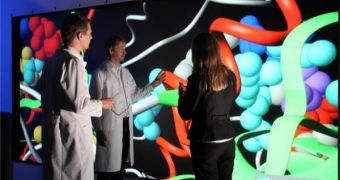Perhaps the greatest problem with treatments available today for most conditions is the fact that they address the symptoms and not the root causes of the conditions. Analyzing the interactions of proteins, which occur at very tiny scales, scientists need powerful observational tools. However, not even the most advanced ones can offer a complete and clear picture of what goes on inside cells. A new piece of simulation software, dubbed BioBrowser, will provide researchers with a powerful tool of modeling 3D proteins in real time from now on, ScienceDaily reports.
Severe challenges face experts in tests aimed at determining the 3D structure of proteins. Being able to view them from all angles is extremely important for two simple reasons. First off, it becomes a lot easier to assess the efficiency of antibiotics, by observing where they bind on the tiny structures. Second, the same line of reasoning applies to extremely toxic pathogens, which utilize weaknesses in proteins in order to corrupt them, and force them to act against the invaded organism.
In the most widely used piece of software today, the quality of the images obtained is fairly low, and leaves a lot of room for improvement. That is not to say that it doesn't do the job. It's a lot better than having nothing to work with. But Austrian researchers from the Fraunhofer Institute Visual Computing department, in Graz, have developed the new piece of software precisely to break away from the limitations that the current program has. By using it, scientists can observe high-detail protein models, even in the case of larger proteins, which contain thousands of atoms.
“When examining molecules, an enormous flood of data is generated that in itself makes little sense at all. BioBrowser converts this data into graphic images and makes the links between different molecules visible,” Dr. Eva Eggeling, who is the head of Visual Computing at the Fraunhofer Institute, explains the operating principle of the new piece of simulation software. She reveals that some protein models can incorporate as much as 50,000 atoms, whose interactions and connections must be observed, if the role and behavior of the entire structure is to be explained accurately.
With BioBrowser, the researchers can get an accurate view of the targeted proteins, and also interact with them. With a simple push of a button, they can rotate the entire structure, or go deep within it, all in high resolution and under the best possible technical conditions. The Austrian team is right now working on smaller details of its piece of simulation software, such as improving the user interface, for more ease of use.

 14 DAY TRIAL //
14 DAY TRIAL //